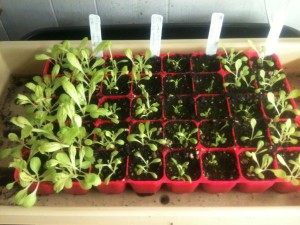As a grower, or, as Aristotle would say, even more basically as a knower, I want to have a sense of what is the best or the excellence of any particular thing. A prize-winning performance from any kind of vegetable or fruit may come from the care and technique in growing it, but there is also something that resides in the thing itself that may cause some to rise to the top of the heap. While among humans that may be called drive, vision, or talent, among vegetables it is called variety (or, more technically correct, cultivar…a cultivated variety). The myriad varieties of vegetables are marked by an often amusing, if not poetic, plethora of names, but the names mean something – they preserve sometimes subtle sometimes blatant differences among what we lump together into a larger class. Think of all the colors of tomatoes alone and then names that capture them, like Taxi and Cherokee Purple, and you start to realize the importance of naming and thus maintaining the differences.
While seed catalogs engage in verbal gymnastics to tease out subtle differences between sometimes similar varieties of a crop, I have found that there’s nothing like personal experience and observation to really get to know how different varieties behave. This year I’m taking on a sometimes persnickety but rewarding crop to grow – Romaine lettuce (also called Cos. Why is it called Cos? Be-cos. No, really, it’s said to come from the Greek island of Cos). This is not just impartial fact finding. Among all the pleasures of my table, it is hard to beat a well-made Caesar salad, and of course the chief ingredient in such a masterpiece is thick-ribbed, crunchy Romaine.
One of the banes of the Romaine grower is to harvest a deep green, heavily textured and handsome head of lettuce only to peel back the outer leaves and find that inside the edges of the inner leaves, called the margins, are brown, curled, and ugly. It’s the notorious condition called tip burn. Talk about ruining one’s appetite for a delicious lemony Caesar salad…you’re left mulling over your losses while crunching croutons. I am aiming to trial eight different Romaine varieties, some I’ve tried before, some unknown to me, to see how they perform in general and how they resist tip burn. I’m going to try them over many sowings, so they mature under different environmental conditions (environmental conditions can cause tip burn under certain circumstances, independent of whether the soil is good and the watering steady…more on that in a later post). In all cases I am using new seed from Territorial Seed Company and planting it in the same potting mix as well as fertilizing the same once I transplant. I’m going to plant each trial in both my home garden and at the Noble Rot, so I’ll have at least two soil types to compare across.
Here are the varieties I’m trialing (basically all of Territorial’s green Romaines): Eiffel Tower, Winter Density, Little Gem, Montecarlo, Flashy Trout’s Back, Valmaine, Bullet, and Super Jericho. There’s geography, boasts, and job descriptions aplenty even in that small collection of names, so we’ll see if they live up to their grand self-billings (well, all except Little Gem – it’s no boaster, just a cute little puppy-like lettuce). First seeding was on day 56 (Feb. 25) and already on day 70, 14 days later, it’s clear that Flashy Trout Back is head and shoulders above the rest. But as we know from our childhood fables, the race is not always to the swiftest, so I watch and wait, with anchovies, Parmesan cheese, and pepper grinder at the ready.

